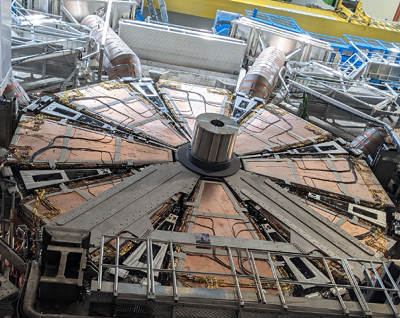
Une des deux nouvelles petites roues (New Small Wheel A) dans la caverne d’ATLAS. Les bobines du spectromètre à muons d’ATLAS sont visibles autour de la roue. En position de fonctionnement, la roue est insérée à l'intérieur du spectromètre. Chaque roue est composée de 16 secteurs. Sur la photo, seuls les 8 grands secteurs sont visibles, tandis que les 8 petits secteurs sont intercalés entre les grands secteurs et recouverts d'une barre d'alignement.
The New Small Wheels (NSW) are the most important project of the ATLAS Phase-1 upgrade towards the High-Luminosity LHC. IRFU has been heavily involved in the design, construction, integration, commissioning and operations of the NSW. The NSW combine two complementary gas detector technologies: sTGC (small-strip Thin Gap Chambers), and Micromegas (Micro-Mesh Gaseous Structure). The latter was pioneered at CEA-Saclay in collaboration with CERN in the 1990’s. It is the first time that the Micromegas technology is used at such a large scale: the NSW contain a total of 1200 m2 of Micromegas planes, one third of which were constructed by IRFU at Saclay. Both wheels were installed in 2021, in time for the beginning of the LHC Run 3. Since spring 2024, both sTGC and Micromegas technologies contribute to the muon endcap trigger, improving the background rejection by more than a factor two, and reducing the trigger rate from 25 kHz down to 11 kHz. This allows ATLAS to run at higher luminosity and pile-up than ever before.
The LHC provides collisions to ATLAS at a bunch-crossing rate of 26 millions per second. Since not all collisions are interesting, and because the volume of data would be too large to record all of them, only a small fraction is selected by the ATLAS trigger system. The first level of trigger (Level-1, hardware-based) uses coarse information about the event and makes the decision to keep or reject it in less than 2.5 microseconds, reducing the rate from 26 MHz to 100 kHz . The second level (High-Level Trigger, software-based) does a full reconstruction of the events and reduces the rate by another order of magnitude. The trigger system uses various information from the collision, in particular the presence in the event of rare particles such as muons.

The NSW project was motivated by the need to reduce the high background observed in the muon endcap Level-1 trigger during the LHC Run 1 (2010-2013) in order to be able to cope with the luminosity expected at the High-Luminosity LHC. A muon coming from a collision at the center of the ATLAS detector goes through, in that order: an NSW, an endcap toroid magnet, a first Big Wheel (Middle), then a second Big Wheel (Outer). Originally only the Big Wheels Middle were equipped with a trigger system. The main purpose of the NSW is to add another layer of triggering in front of the endcap toroid magnet to veto particles not coming from the interaction point. The design chosen was a combination of two technologies both capable of triggering (requiring a quick response and a precise time measurement) and precise tracking reconstruction. The first one uses small-strip Thin Gap Chambers (sTGC, emphasis on triggering) with pads (rectangles about 8 cm wide in the bending plane), 3.2 mm-pitch strips, and wires orthogonal to the strips and pads. The second one uses Micromegas (Micro-Mesh Gaseous Structure) chambers with resistive strips of less than half a millimeter of pitch (emphasis on precision tracking). With 8 layers of measurement each, the two technologies offer a good redundancy. As part of the ATLAS phase-1 upgrade programme the wheels were installed in 2021, at the end of the LHC Long Shutdown 2 (LS2, 2019-2021), just before the start of the LHC Run 3 (2022-2026).

The muon endcap trigger puts NSW information in coincidence with the Big Wheels Middle trigger system. The NSW trigger is being implemented in several steps. As a first step, in 2023 several sectors were activated using the sTGC pad trigger only, which does not require the use of the dedicated NSW trigger processor. On May 8th 2024, NSW information was included in up to 85 % of the trigger sectors, leading to a Level-1 trigger rate reduction from 25 kHz to 13 kHz. On May 21st 2024, information from Micromegas for those same sectors was added for the very first time. Finally, on May 28th 2024, thanks to the addition of Micromegas information, all remaining sectors (some suffering from low sTGC efficiency) could be included, leading to a total reduction of the main Level-1 muon trigger rate of 14 kHz, while retaining 96% of the interesting muons. The total ATLAS trigger rate is limited to 100 kHz, so a 14 kHz reduction is significant, and allows to take data at higher luminosity. Currently ATLAS is able to take data with an instantaneous luminosity of 2.2 1034 cm-2s-1 at 13.6 TeV, which produces 65 pile-up events per bunch-crossing. The addition of Micromegas information is especially interesting in sectors suffering from low sTGC efficiency: not only does it increase the trigger efficiency, but it also allows to activate sectors that would not be efficient enough otherwise, thus contributing to the background reduction as well.

In Run 4 (expected to start in 2030), the luminosity will be up to three times higher than today, putting even more pressure on the trigger. The next step for the NSW will be to use, in addition to the sTGC pads and the Micromegas strips, the sTGC strips, providing a more precise reconstruction than the sTGC pads and additional redundancy, thus reducing further the background.

Contact:
• Constituants élémentaires et symétries fondamentales › Physique des particules auprès des collisionneurs Détection des rayonnements › Détecteurs pour la physique des 2 infinis
• Institute of Research into the Fundamental Laws of the Universe • The Particle Physics Division
• ATLAS • ATLAS-Muons



